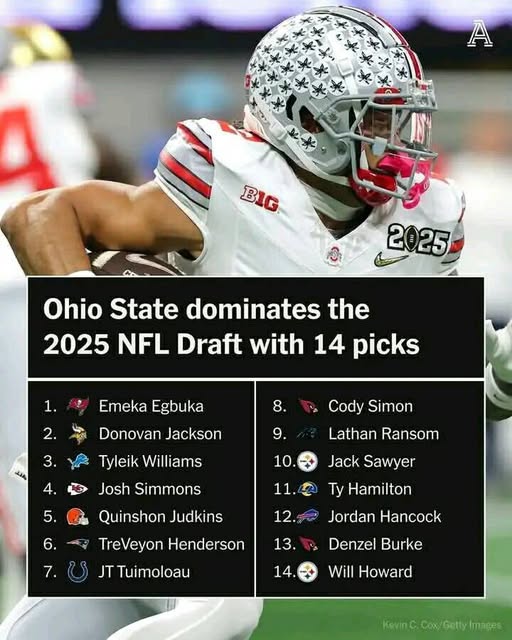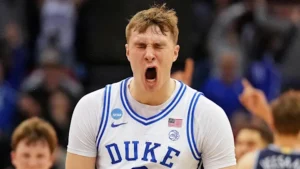
The Buckeyes’ dominance in the draft: Ohio State establishes a program record with 14 selections in a single draft, securing its place as a college football powerhouse and displaying an unwavering dedication to developing a winning roster.
The 2004 NFL Draft stands as a monumental testament to Ohio State University’s prowess in developing elite football talent. With 14 players selected, the Buckeyes set a new school record, surpassing the previous high of 12 set in 1971 and equaled in 1975 during the 17-round draft era . This achievement not only solidified Ohio State’s reputation as a powerhouse in college football but also highlighted its unwavering commitment to cultivating a winning roster.
A Historic Draft Class
The 2004 draft was a showcase of Ohio State’s depth and talent across various positions. The first round alone saw three Buckeyes selected:
-
Will Smith (DE): Picked 18th overall by the New Orleans Saints, Smith was a consensus All-American and the Big Ten Defensive Player of the Year in 2003. His explosive pass-rushing ability made him a coveted prospect.
-
Chris Gamble (CB): Chosen 28th overall by the Carolina Panthers, Gamble was a dynamic playmaker known for his versatility, excelling as both a cornerback and a wide receiver during his college career.
-
Michael Jenkins (WR): Selected 29th overall by the Atlanta Falcons, Jenkins concluded his Ohio State career as the school’s all-time leader in receiving yards, amassing 2,898 yards and 16 touchdowns .
The third round was equally impressive, with seven Buckeyes drafted:
-
Ben Hartsock (TE): Picked 68th overall by the Indianapolis Colts, Hartsock was known for his exceptional blocking skills and reliable hands.
-
Tim Anderson (DT): Selected 74th overall by the Buffalo Bills, Anderson was a stalwart on the defensive line, known for his strength and tenacity.
-
Darrion Scott (DE): Chosen 88th overall by the Minnesota Vikings, Scott was a disruptive force on the edge, contributing significantly to Ohio State’s defensive success.
-
B.J. Sander (P): Drafted 87th overall by the Green Bay Packers, Sander was renowned for his punting accuracy and distance, providing the Buckeyes with a strong field-position advantage.
The fourth round saw additional talent:
-
Alex Stepanovich (C): Picked 100th overall by the Arizona Cardinals, Stepanovich was a durable and intelligent center, anchoring Ohio State’s offensive line.
-
Will Allen (S): Selected 111th overall by the Tampa Bay Buccaneers, Allen was a hard-hitting safety with excellent coverage skills.
The fifth round continued the trend:
-
Craig Krenzel (QB): Chosen 148th overall by the Chicago Bears, Krenzel was a two-time national champion and a leader on and off the field.
-
Drew Carter (WR): Picked 163rd overall by the Carolina Panthers, Carter was a speedy receiver with big-play potential.
-
Robert Reynolds (ILB): Selected 165th overall by the Tennessee Titans, Reynolds was known for his leadership and tackling prowess.
The seventh round concluded the Buckeyes’ remarkable draft performance:
-
Shane Olivea (OT): Drafted 209th overall by the San Diego Chargers, Olivea was a powerful offensive tackle with a strong work ethic.
-
Adrien Clarke (OG): Picked 227th overall by the Philadelphia Eagles, Clarke was a versatile guard capable of playing multiple positions on the line.
Additionally, quarterback Scott McMullen signed a free-agent contract with the Philadelphia Eagles, bringing the total number of Buckeyes entering the NFL to 15 .
The influence of Ohio State’s 2004 draft class extended far beyond the collegiate level. Many of these players enjoyed successful NFL careers:
-
Will Smith became a dominant defensive end, earning Pro Bowl honors and contributing significantly to the New Orleans Saints’ defense.
-
Chris Gamble was known for his ball-hawking skills, recording numerous interceptions and establishing himself as a key figure in the Panthers’ secondary.
-
Michael Jenkins had a productive career, amassing over 4,400 receiving yards and 25 touchdowns, and was part of the Falcons’ offense for several seasons.
-
Ben Hartsock carved out a niche as a reliable blocking tight end, playing for multiple NFL teams over his career.
-
Tim Anderson and Darrion Scott provided depth and strength to their respective defensive lines, contributing to their teams’ defensive success.
-
B.J. Sander had a notable stint as a punter, known for his ability to change field position.
-
Alex Stepanovich and Shane Olivea anchored their offensive lines, providing stability and protection for their quarterbacks.
-
Will Allen and Robert Reynolds were known for their leadership and defensive contributions, making significant impacts on their teams.
-
Craig Krenzel and Drew Carter added depth to their teams’ rosters, with Krenzel’s leadership and Carter’s speed being assets.
-
Adrien Clarke provided versatility on the offensive line, contributing to the success of his teams.
This remarkable draft class not only showcased Ohio State’s ability to produce NFL-caliber talent but also underscored the program’s commitment to excellence and player development.
The 2004 NFL Draft remains a high point in Ohio State’s storied football history. It demonstrated the program’s ability to recruit and develop top-tier talent across all positions. The success of these players in the NFL further solidified Ohio State’s reputation as a premier football program.
In the years following, Ohio State continued to produce NFL talent at a high rate, maintaining its status as a “feeder school” for the professional league. The 2004 draft class set a standard for future Buckeye teams, inspiring subsequent generations of players to strive for excellence both on the field and in their professional aspirations.
The legacy of the 2004 draft class serves as a reminder of Ohio State’s enduring commitment to developing well-rounded, talented athletes capable of succeeding at the highest levels of competition. It stands as a testament to the program’s dedication to fostering a winning culture and producing players who excel both on the field and in their post-collegiate careers.





